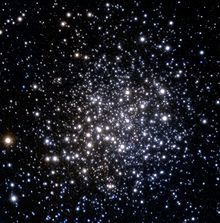- Millisecond pulsar
-
A millisecond pulsar (MSP) is a pulsar with a rotational period in the range of about 1-10 milliseconds. Millisecond pulsars have been detected in the radio, X-ray, and gamma ray portions of the electromagnetic spectrum. The origin of millisecond pulsars is still unknown. The leading theory is that they begin life as longer period pulsars but are spun up or "recycled" through accretion. For this reason, millisecond pulsars are often called recycled pulsars.
Millisecond pulsars are thought to be related to low-mass X-ray binary systems. It is thought that the X-rays in these systems are emitted by the accretion disk of a neutron star produced by the outer layers of a companion star that has overflowed its Roche lobe. The transfer of angular momentum from this accretion event can theoretically increase the rotation rate of the pulsar to hundreds of times a second, as is observed in millisecond pulsars.
However, there has been recent evidence that the standard evolutionary model fails to explain the evolution of all millisecond pulsars, especially young millisecond pulsars with relatively high magnetic fields, e.g. PSR B1937+21. Kızıltan & Thorsett showed that different millisecond pulsars must form by at least two distinct processes.[1] But the nature of the other process remains a mystery.[2]
Many millisecond pulsars are found in globular clusters. This is consistent with the spin-up theory of their formation, as the extremely high stellar density of these clusters implies a much higher likelihood of a pulsar having (or capturing) a giant companion star. Currently there are approximately 130 millisecond pulsars known in globular clusters.[3] The globular cluster Terzan 5 alone contains 33 of these, followed by 47 Tucanae with 22 and M28 and M15 with 8 pulsars each.
Millisecond pulsars, which can be timed with high precision, are better clocks than the best atomic clocks. This also makes them very sensitive probes of their environments. For example, anything placed in orbit around them causes periodic Doppler shifts in their pulses' arrival times on Earth, which can then be analyzed to reveal the presence of the companion and, with enough data, provide precise measurements of the orbit and the object's mass. The technique is so sensitive that even objects as small as asteroids can be detected if they happen to orbit a millisecond pulsar. The first confirmed exoplanets discovered several years before the first detections of exoplanets around “normal” solar-like stars, were found in orbit around a millisecond pulsar, PSR B1257+12. These planets remained for many years the only Earth-mass objects known outside our solar system. And one of them, with an even smaller mass, comparable to that of our Moon, is still today the smallest-mass object known beyond the solar system.[4]
Pulsar rotational speed limits
The first millisecond pulsar, PSR B1937+21, was discovered in 1982 by Backer et al. Spinning roughly 641 times a second, it remains the second swiftest-spinning millisecond pulsar of the approximately 180 that have been discovered.[5] Pulsar PSR J1748-2446ad, discovered in 2005, is, as of 2010, the swiftest spinning pulsar currently known, spinning 716 times a second.[6][7]
Current theories of neutron star structure and evolution predict that pulsars would break apart if they spun at a rate of ~1500 rotations per second or more,[8][9] and that at a rate of above about 1000 rotations per second they would lose energy by gravitational radiation faster than the accretion process would speed them up.[10]
However, in early 2007 data from the Rossi X-ray Timing Explorer and INTEGRAL spacecraft discovered a neutron star XTE J1739-285 rotating at 1122 Hz.[11] The result is not statistically significant, with a significance level of only 3 sigma. Therefore, while it is an interesting candidate for further observations, current results are inconclusive. Still, it is believed that gravitational radiation plays a role in slowing the rate of rotation. Furthermore, one X-ray pulsar that spins at 599 revolutions per second, IGR J00291+5934, is a prime candidate for helping detect such waves in the future (most such X-ray pulsars only spin at around 300 rotations per second).
References
- ^ Kızıltan, Bülent; Thorsett, S. E. (2009). "Constraints on Pulsar Evolution: The Joint Period-Spin-down Distribution of Millisecond Pulsars". The Astrophysical Journal Letters 693 (2): L109–L112. Bibcode 2009ApJ...693L.109K. doi:10.1088/0004-637X/693/2/L109
- ^ Naeye, Robert (2009). "Surprising Trove of Gamma-Ray Pulsars". Sky & Telescope. http://www.skyandtelescope.com/news/37345099.html
- ^ Freire, Paulo. "Pulsars in globular clusters". Arecibo Observatory. http://www2.naic.edu/~pfreire/GCpsr.html. Retrieved 2007-01-18.
- ^ Rasio, Frederic (2011). "Planet Discovery near Pulsars". Science. http://www.sciencemag.org/content/333/6050/1712.full
- ^ "The ATNF Pulsar Database". http://www.atnf.csiro.au/research/pulsar/psrcat/proc_form.php?Name=Name&P0=P0&P1=P1&startUserDefined=true&c1_val=&c2_val=&c3_val=&c4_val=&sort_attr=p0&sort_order=asc&condition=&pulsar_names=&ephemeris=short&coords_unit=raj%2Fdecj&radius=&coords_1=&coords_2=&style=Long+with+last+digit+error&no_value=*&fsize=3&x_axis=&x_scale=linear&y_axis=&y_scale=linear&state=query&table_bottom.x=74&table_bottom.y=20. Retrieved 2009-05-17.
- ^ Hessels, Jason; Ransom, Scott M.; Stairs, Ingrid H.; Freire, Paulo C. C.; Kaspi, Victoria M.; Camilo, Fernando (2006). "A Radio Pulsar Spinning at 716 Hz". Science 311 (5769): 1901–1904. arXiv:astro-ph/0601337. Bibcode 2006Sci...311.1901H. doi:10.1126/science.1123430. PMID 16410486
- ^ Naeye, Robert (2006-01-13). "Spinning Pulsar Smashes Record". Sky & Telescope. http://www.skyandtelescope.com/news/3311021.html?page=1&c=y. Retrieved 2008-01-18
- ^ Cook, G. B.; Shapiro, S. L.; Teukolsky, S. A. (1994). "Recycling Pulsars to Millisecond Periods in General Relativity". Astrophysical Journal Letters 423: 117–120. Bibcode 1994ApJ...423L.117C. doi:10.1086/187250.
- ^ Haensel, P.; Lasota, J. P.; Zdunik, J. L. (1999). "On the minimum period of uniformly rotating neutron stars". Astronomy and Astrophysics 344: 151–153. Bibcode 1999A&A...344..151H.
- ^ Chakrabarty, D.; Morgan, E. H.; Muno, M. P.; Galloway, D. K.; Wijnands, R.; van der Klis, M.; Markwardt, C. B. (2003). "Nuclear-powered millisecond pulsars and the maximum spin frequency of neutron stars". Nature 424 (6944): 42–44. arXiv:astro-ph/0307029. Bibcode 2003Natur.424...42C. doi:10.1038/nature01732. PMID 12840751. http://www.nature.com/nature/journal/v424/n6944/abs/nature01732.html. Retrieved 2010-02-14.
- ^ "Integral points to the fastest spinning neutron star". Spaceflight Now (European Space Agency). 2007-02-19. http://www.spaceflightnow.com/news/n0702/19neutronstar/. Retrieved 2007-02-20
External links
- "Pinning Down a Pulsar’s Age". Science News.
- "How Millisecond Pulsars Spin So Fast". Universe Today.
- "Fast-Spinning Star Could Test Gravitational Waves". New Scientist.
- "Astronomical whirling dervishes hide their age well". Astronomy Now.
- Audio: Cain/Gay - Pulsars Astronomy Cast - Nov 2009.
Categories:- Pulsars
- Millisecond pulsars
Wikimedia Foundation. 2010.

